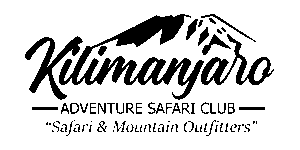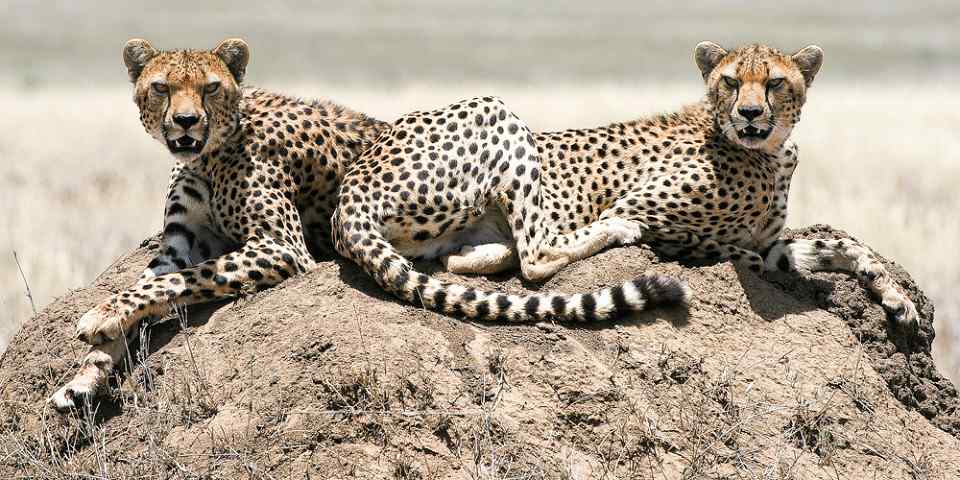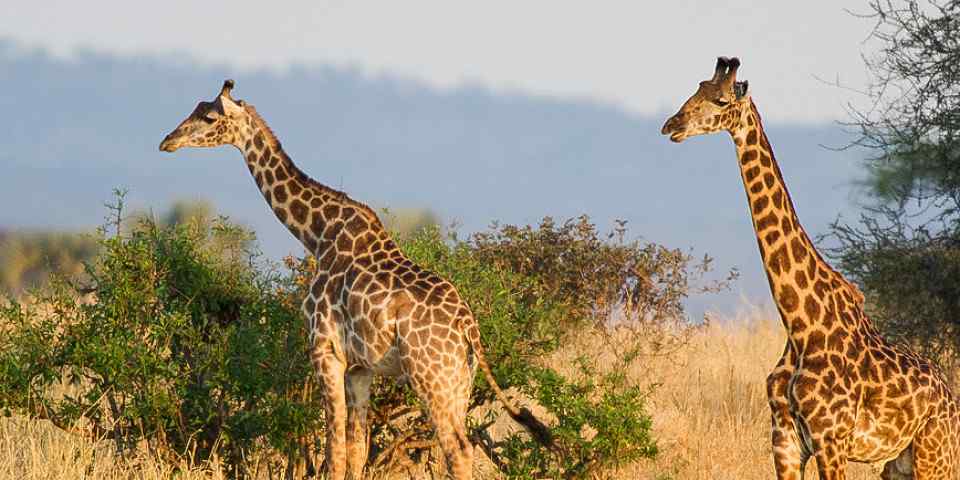Tour Length
Rates in USD $ – Change Currency
Per person, excl. international flightsOperator Rating
Other Tour Features
Filter by Operator
Filter by Accommodation
4-Day Serengeti Safari Tours
Going on a 4-day Serengeti National Park safari is one of the best experiences you can have in Africa. It’s a chance to explore one of the best safari parks anywhere on the continent, with its endless savannah grasslands, flat-topped acacia trees and extraordinary wildlife. For part of the year, the Serengeti provides the backdrop to the great migration, the annual procession of 2 million wildebeest, zebra and Thomson’s gazelle, and one of the most incredible sights in nature. But the Serengeti is an extraordinary wildlife destination even when the migration is elsewhere. That’s because this is a vast and beautiful land that is filled with animals, and on your 4-day safari you’re in for the most wonderful time.
-
Top Rated Operator

4-Day Serengeti Luxury Tour in Tanzania
$4,099 to $4,299 pp (USD)
Tanzania: Private tourLuxuryTented Camp
You Visit: Arusha (Start), Serengeti NP, Arusha (End)

Wayfairer Travel

4.8/5 – 182 Reviews
-
Top Rated Operator

4-Day Above and Beyond - Luxury
$2,640 to $3,090 pp (USD)
Tanzania: Private tourLuxuryTented Camp
You Visit: Arusha (Start), Serengeti NP, Arusha (End)

Soul of Tanzania
5.0/5 – 501 Reviews
-
Top Rated Operator

4-Day A Quick Fly-in Safari from Beach to Bush
$2,504 pp (USD)
Tanzania: Private tour
Mid-range Tented CampYou Visit: Zanzibar (Start), Serengeti NP, Zanzibar (End)

Paradise & Wilderness
4.8/5 – 224 Reviews
-

4-Day Amazing Tarangire Serengeti and Ngorongoro
$1,595 pp (USD)
Tanzania: Private tour
Mid-range Lodge & Tented Bush CampYou Visit: Arusha (Start), Tarangire NP, Serengeti NP, Ngorongoro Crater, Arusha (End)

African Chitah
4.9/5 – 86 Reviews
-
![4-Day Private Camping Tarangire, Serengeti & Ngorongoro]()
4-Day Private Camping Tarangire, Serengeti & Ngorongoro
$1,471 pp (USD)
Tanzania: Private tourBudgetCamping
You Visit: Arusha (Start), Tarangire NP, Serengeti NP, Ngorongoro Crater, Arusha (End)

Lekobe Adventures Safaris
4.9/5 – 51 Reviews
-
![4-Day Manyara NP, Serengeti NP & Crater Luxury Safari]()
4-Day Manyara NP, Serengeti NP & Crater Luxury Safari
$2,255 pp (USD)
Tanzania: Private tourLuxuryLodge
You Visit: Arusha (Start), Lake Manyara NP, Serengeti NP, Central Serengeti NP, Ngorongoro Crater, Moshi (End)

Amshar Serengeti Adventures
4.9/5 – 146 Reviews
-
Top Rated Operator
![4-Day Private Luxury Safari with Five Star Service]()
4-Day Private Luxury Safari with Five Star Service
$2,950 pp (USD)
Tanzania: Private tourLuxuryLodge
You Visit: Arusha (Start), Tarangire NP, Serengeti NP, Ngorongoro Crater, Arusha (End)

Mountain Warriors Tours and Safaris
4.9/5 – 242 Reviews
-
Top Rated Operator
![4-Day Luxury Tour, Tarangire, Serengeti and Ngorongoro]()
4-Day Luxury Tour, Tarangire, Serengeti and Ngorongoro
$2,133 pp (USD)
Tanzania: Private tourLuxuryLodge
You Visit: Arusha (Start), Tarangire NP, Serengeti NP, Ngorongoro Crater, Arusha (End)

Full Package Adventures
5.0/5 – 220 Reviews
-
Best Seller
![4-Day Mid-Range Lodge Group Tour]()
4-Day Mid-Range Lodge Group Tour
$1,375 pp (USD)
Tanzania: Shared tour (max 6 people per vehicle)
Mid-range Lodge & Tented Bush CampYou Visit: Arusha (Start), Tarangire NP, Serengeti NP, Ngorongoro Crater, Arusha (End)

Suricata Safaris
5.0/5 – 2,770 Reviews
-
![4-Day Exclusive Safari from Zanzibar to 3 Special Parks]()
4-Day Exclusive Safari from Zanzibar to 3 Special Parks
$2,377 pp (USD)
Tanzania: Private tourLuxuryLodge & Tented Camp
You Visit: Zanzibar (Start), Tarangire NP, Ngorongoro Crater, Serengeti NP, Zanzibar (End)

Goldfinch Adventures
5.0/5 – 49 Reviews
-
Top Rated Operator
![4-Day Tanzania Northern Circuit Experience]()
4-Day Tanzania Northern Circuit Experience
$1,716 pp (USD)
Tanzania: Private tour
Mid-range Lodge & Tented CampYou Visit: Arusha (Start), Tarangire NP, Serengeti NP, Karatu (Town), Lake Manyara NP, Arusha (End)

Kilimanjaro Adventure Safari Club
5.0/5 – 198 Reviews
-
Top Rated Operator
![4-Day Classic Tour to Tarangire, Serengeti & Ngorongoro]()
4-Day Classic Tour to Tarangire, Serengeti & Ngorongoro
$1,602 pp (USD)
Tanzania: Private tour
Mid-range Lodge & Tented CampYou Visit: Arusha (Start), Tarangire NP, Serengeti NP, Ngorongoro Crater, Arusha (End)

Serengeti Smile
5.0/5 – 577 Reviews
-
Top Rated Operator
![4-Day Fly in Zanzibar to Northern Circuit Classic Safari]()
4-Day Fly in Zanzibar to Northern Circuit Classic Safari
$2,530 pp (USD)
Tanzania: Private tourLuxuryLodge & Tented Camp
You Visit: Zanzibar (Start), Serengeti NP, Ngorongoro Crater, Tarangire NP, Zanzibar (End)

Serengeti Wakanda Tours and Safaris
5.0/5 – 619 Reviews
-
Top Rated Operator
![4-Day Magic Experience Safari Mix Lodge & Camp]()
4-Day Magic Experience Safari Mix Lodge & Camp
$1,202 pp (USD)
Tanzania: Shared tour (max 7 people per vehicle)
Mid-range Camping & LodgeYou Visit: Arusha (Start), Tarangire NP, Serengeti NP, Ngorongoro Crater, Arusha (End)

Go Serengeti African Tours
4.9/5 – 291 Reviews
-
![4-Day Wildest Tanzania Safari]()
4-Day Wildest Tanzania Safari
$1,410 pp (USD)
Tanzania: Private tour
Mid-range Tented CampYou Visit: Arusha (Start), Lake Natron, Serengeti NP, Ngorongoro Crater, Tarangire NP, Arusha (End)

Safari360
4.8/5 – 131 Reviews
-
Best Seller
![4-Day Experience Camping and Lodge Safari]()
4-Day Experience Camping and Lodge Safari
$1,100 pp (USD)
Tanzania: Shared tour (max 7 people per vehicle)
Mid-range Camping & LodgeYou Visit: Arusha (Start), Tarangire NP, Serengeti NP, Arusha (End)

Go Makini Tanzania Expedition
4.9/5 – 70 Reviews
-
Top Rated Operator
![4-Day Join Group Serengeti & Ngorongoro]()
4-Day Join Group Serengeti & Ngorongoro
$715 pp (USD)
Tanzania: Shared tour (max 6 people per vehicle)BudgetCamping & Hotel
You Visit: Arusha (Start), Serengeti NP, Ngorongoro Crater, Arusha (End)

Meru Slopes Tours & Safaris
5.0/5 – 460 Reviews
-
Top Rated Operator
![4-Day Luxury Serengeti Safari]()
4-Day Luxury Serengeti Safari
$2,915 to $3,465 pp (USD)
Tanzania: Private tourLuxuryLodge
You Visit: Zanzibar (Start), Serengeti NP, Zanzibar (End)

Safari Soles
5.0/5 – 339 Reviews
-
Top Rated Operator
![4-Day Northern Parks Budget]()
4-Day Northern Parks Budget
$1,477 pp (USD)
Tanzania: Private tourBudgetTented Camp
You Visit: Arusha (Start), Tarangire NP, Serengeti NP, Ngorongoro Crater, Arusha (End)

Shemeji Safari Tanzania
4.8/5 – 294 Reviews
-
Top Rated Operator
![4-Day Private Safari with Serena Collection]()
4-Day Private Safari with Serena Collection
$2,604 pp (USD)
Tanzania: Private tourLuxuryLodge
You Visit: Arusha (Start), Tarangire NP, Serengeti NP, Arusha (End)

Gamedrive Travel Africa Safari Agency
5.0/5 – 516 Reviews
7 Questions About 4-Day Serengeti Safaris

Answered by
Anthony Ham
Anthony has been writing about Africa in general and safaris in particular for nearly two decades. He has covered northern Tanzania, including the Serengeti, for Lonely Planet in its ‘Tanzania’ and ‘East Africa’ guidebooks. He is also the author of ‘The Last Lions of Africa’.› More about Anthony
7 Questions About 4-Day Serengeti Safaris
 Anthony Ham
Anthony Ham
Is 4 days too short for a trip in the Serengeti?
“Because the Serengeti is such a wonderful place, you can never have too much time there, and in this sense, yes, 4 days is too short. But the same could be said for a week or even more. To get more than just a fleeting glimpse or a taste of what the Serengeti has to offer, 4 days is actually an excellent amount of time to dedicate to a safari here. In 4 days, you can get to know just one area of the park really well, or maybe even explore a few areas. This may mean a couple of days in the Southern Serengeti and another couple in the central Seronera area. The Northern Serengeti is a little further away, which means you may want to spend the whole of your 4-day tour in the north. Either way, in 4 days, you can see so many animals, enjoy a range of different landscapes, and maybe even have some time to relax in between your explorations.”
1How do I get to the Serengeti?
“There are a number of ways for you to get to the Serengeti, and it all depends on what kind of tour you have planned. Many safari travelers fly into one of the airstrips in the Serengeti, either from Arusha or from another safari camp in a different park. By flying into the park, you can maximize your limited time, and also get a wonderful overview of the park and its seemingly endless horizons at the same time. If you only have 4 days for your entire trip (as opposed to 4 days just for the Serengeti section of a longer trip), flying will usually be the best option. If you’re flying, it will usually be in a small plane, which could be anything from a six- to 20-seater aircraft. The other option for getting to the Serengeti is by road. This means that it can take longer to reach the Serengeti, and this may take away from the time you actually have available to spend in the park itself. Then again, the benefit of traveling by road is that you get to see so much at ground level along the way. Depending on where you’re coming from and how much time you have, you may even, for example, be able to visit the Ngorongoro Crater and Olduvai (Oldupai) Gorge on your way to the Serengeti if you’re traveling there by road. If you travel by road, you’ll probably be in a minibus or a 4x4 safari vehicle.”
2What accommodation can I expect in the Serengeti?
“As always, the type of accommodation you can expect in the Serengeti will vary depending on the type of safari you have planned. As a general rule, however, the Serengeti has an excellent range of accommodation to suit most budgets. For many travelers, staying in one of the Serengeti’s tented camps is a real highlight. These camps have safari tents that, at their most simple, have a bed and an attached toilet and (sometimes outdoor) shower. At the more expensive end of the market, these tents are the height of luxury, with lots of space and fine safari furnishings. As part of these camps, there is usually a dining tent, a lounge area and sometimes even a swimming pool. Some of the tented camps are mobile, which means that they change location a couple of times a year, usually to maximize your chances of seeing the great migration. Either way, one of the best things about a tented camp is that only canvas separates you from the African wild. It’s perfectly safe and you’ll feel like a part of the Serengeti, especially when you lie awake and listen to lions roaring in the night. The Serengeti also has a number of lodges, which are more permanent structures. In a lodge, you’ll sleep behind four walls. Otherwise, the experience is similar to a tented camp, with a dining area, possibly a bar and sometimes a swimming pool. At the budget end of the spectrum, there are some camping areas and a youth hostel at Seronera in the Central Serengeti.”
3What is the best time of the year for a 4-day safari in the Serengeti?
“There is no bad time to visit the Serengeti, but your experience will differ according to which months you’re here. When it comes to the weather, the best time for visiting the Serengeti is undoubtedly the Dry season, which runs from June to October. During these months, you can expect little or no rainfall. Leaving aside the timing of the great migration for a moment, these months also coincide with the best months for wildlife viewing. That’s because during the dry months, the animals tend to gather close to the last remaining water sources, which can make them easier to find. There are other considerations to take into account. The movement of the wildebeest, zebra, Thomson’s gazelle and other species through the park during the migration follows a quite discernible pattern. Wildebeest usually give birth to hundreds of thousands of calves in the Southern Serengeti in January and February. In June and/or July, they can often be seen further north as they cross the Grumeti River in the Serengeti’s central Western Corridor. And they usually cross the Mara River into Kenya in the Serengeti’s far north around September. All of these dates can, of course, change from one year to the next, but they’re a useful guide for planning based on the ‘normal’ course of events.”
4Is it likely that I will see the wildebeest migration?
“To see the migration on your 4-day Serengeti National Park safari, you’ll need both careful planning and a little bit of luck. As a general rule, the wildebeest, zebra, Thomson’s gazelle and other migrating species pass through the park during certain months. They usually begin in the Serengeti’s far south in January and February, then slowly move north over the months that follow. By June and/or July, they’re often in the Western Corridor, in the vicinity of the Grumeti River and Grumeti Game Reserve. They usually leave the Serengeti and cross the Mara River into Kenya’s Masai Mara National Reserve in September. These general guidelines should form the basis of your planning if you want to see the migration. And yet, no two years are the same and, as with any wildlife encounter, nothing can be guaranteed. There are years when these dates prove to be accurate, but there are just as many when the wildebeest travel more quickly or more slowly through the park, or head north without heading west, or some other variation on the norm. That’s why you need luck if you are to be in the right place at the right time.”
5Which animals am I likely to see?
“There are so many animals to see when you visit the Serengeti on your 4-day safari that it’s impossible to list them all. And which animals you see can depend on where you go in the Serengeti, and when it is that you’re traveling. If you’re here during the great migration, then you’ll almost certainly see countless wildebeest, zebra and Thomson’s gazelle. Whenever the migration is passing through, you’ll often see predators (especially big cats and spotted hyenas) nearby as they take advantage of the ready food supply. During the migration, and at other times, big cats and spotted hyena are always a possibility. Elephant, buffalo and giraffe are also commonly seen, as are golden and black-backed jackal, bat-eared fox and a wide range of antelope species, including eland, topi, kongoni and impala. Black rhino is the most elusive species of the Big Five and sightings are rare, but they are present in the park.”
6How much does a 4-day Serengeti safari cost?
“There are many variables in trying to work out how much your 4-day safari in the Serengeti will cost. These include the time of year when you’re traveling, the type of accommodation you want to stay in, and the type of safari (group, private or self-drive) you’d like to go on. High season runs from July through to March, and these months are when you can expect everything to cost a little more. Prices also increase significantly whenever the migration is expected in the area you’re visiting. Accommodation is also a factor, with everything from camping safaris to luxury tented camp or lodge accommodation. How much comfort and luxury you need will have a big influence on the overall cost of your safari. The same applies to safari types: private safaris generally cost more (sometimes significantly more) than group safaris where you’ll share safari vehicles, guides etc. As a general rule, a simple camping safari in the Serengeti will start at US$100 to US$150 per person per day, while a luxury safari will start at US$500 per person per day and can go much higher. Most safaris cost somewhere in between.”
7Serengeti Reviews

Kim is a travel writer who authored and updated over 15 guidebooks, including Lonely Planet's South Africa and Bradt's Tanzania guides.
The greatest (natural) show on earth
One of the best game reserves in the world, the Serengeti is without a doubt my all-time favourite game park. The Serengeti is one of those places that had long lived in my imagination, before I’d even laid eyes on it. Happily, it more...

Stuart is a travel writer and author of numerous Lonely Planet guidebooks, including 'Kenya', 'Rwanda' and 'Tanzania'.
Classic Africa
What can be said about the Serengeti that hasn’t already been said? This is simply Africa as you always imagined it. Endless rolling bleached grasslands with scattered flat-topped acacia trees and animals everywhere. This is the...
 US
US
The Africa of My Dreams
The Serengeti exceeded my sky-high expectations. What a marvel of nature! In two days in the Serengeti we saw about 20 lions doing all varieties of activities, 6 cheetah including one hunting and a couple of the cutest cubs imaginable, many...
 CH
CH
Immense expanses as far as the eye can see. In the center, many herbivores, zebras, wildebeests, giraffes, gazelles, ... many predators, lion, cheetah, leopard, yennes. In the north, at the Mara River, hippos, large crocodiles, etc. If...
 DE
DE
The Serengeti was an absolute highlight of our trip. The vast plains, teeming with wildlife, left us in awe. We were fortunate to witness the Great Migration, which was truly a once-in-a-lifetime experience. The diversity of animals,...
 NL
NL
This is my number one park. There is always a new road to take and to spot another animals as there are so many. We spotted the big 5 and so much more. From a Cheetah posing for us on a rock to going to hunt a Warthog. Unfortunatly for the...


























_1813_5e20b935b89f3.gif)





